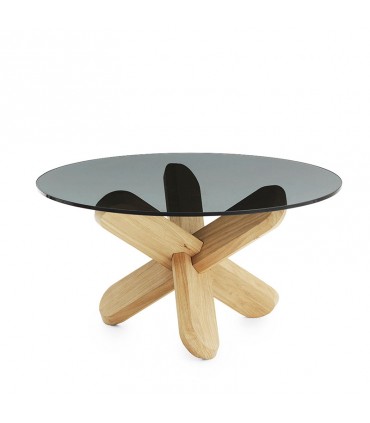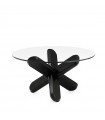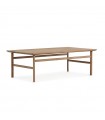Ding Wood coffee table, designed by Rudolph Schelling Webermann, is a table inspired by puzzles. 3 pieces of wood are joined and hooked into a seemingly inseparable knot, on which a round glass board rests.
Ding Wood coffee table, designed by Rudolph Schelling Webermann, for Normann Copenhagen .
The Ding coffee table is a puzzle table.
Inspired by ancient three-dimensional wooden puzzles, German designers Rudolph Schelling Webermann have created a simple coffee table that assembles without the help of screws or tools. The table simply consists of three oak legs. When put together, they form a sculptural knot that functions as the basis for a unique glass tabletop.
When Rudolph Schelling Webermann bought puzzles, they immediately began to experiment and play with the shape and basic principle of the puzzle: three pieces of wood are joined and hooked into a seemingly inseparable knot. During the process, they realized that the shape would make a perfect base for a table. The legs are rounded with beveled edges, making the table stand firmly on the floor and the round glass sheet sits solidly on the base.
Rudolph Schelling Webermann say: "The three legs seem to pierce each other in an impossible way, and our intention is to draw attention to this almost magical detail. That is why we have also chosen a transparent lid, making the key focus point of the table is the union of the legs. "
Material: Glass and Oak Wood
This version of the Ding coffee table has a natural oak wood base
The Ding table comes flat packed.
The legs are easily interlocked by following the included manual.
The legs have beveled edges that make the table rest firmly on the floor and the 12mm thick round glass sheet rests solidly on the base.
Measurements: Diameter of 75cm - Height of 40cm


















